Archived Blog Posts
6 Essential Steps to Take After a Tornado
6/15/2023 (Permalink)
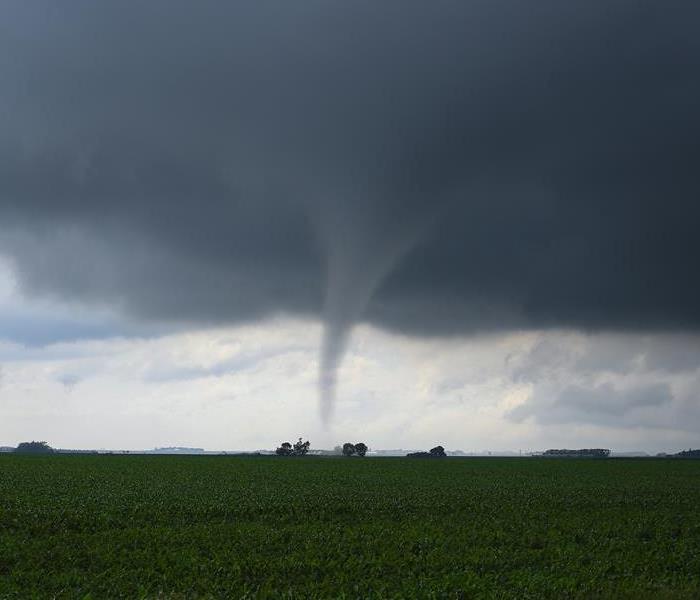 Follow these 6 steps to stay safe and get your property back to its preloss condition.
Follow these 6 steps to stay safe and get your property back to its preloss condition.
Tornadoes are unpredictable and can cause significant damage to homes and businesses. If you have experienced a tornado in your area, it's important to take the necessary steps to ensure your safety and begin the recovery process. Here are 6 steps to take after a tornado:
Ensure Your Safety
The first and most important step after a tornado is to ensure your safety. Check yourself and your loved ones for any injuries, and seek medical attention if needed. If your home is not safe to stay in, find a safe place to go, such as a shelter or hotel.
Assess the Damage
Once you are safe, assess the damage to your property. Take photos or videos of the damage for insurance purposes, and make a list of any damaged items. This will help you file an insurance claim and get the compensation that you need to repair your property.
Contact Your Insurance Company
Contact your insurance company as soon as possible to report the damage and begin the claims process. Provide them with all of the information that they need, including photos and videos of the damage and a list of damaged items.
Call a Professional Restoration Company
It's important to call a professional restoration company like SERVPRO to begin the cleanup and restoration process as soon as possible. Tornado damage can be extensive, and it's important to have a team of experts on your side to help with the cleanup and restoration process.
Secure Your Property
If your property has sustained significant damage, it's important to secure it to prevent further damage or theft. Board up any broken windows or doors, and cover any damaged areas with tarps or plastic sheeting.
Be Patient
Finally, be patient during the recovery process. Tornado damage can take time to repair, and it's important to work with your restoration company and insurance company to ensure that everything is done correctly. Stay in communication with your restoration company and insurance company, and ask any questions that you may have.
In conclusion, if you have experienced a tornado in your area, it's important to take the necessary steps to ensure your safety and begin the recovery process. Follow these 6 steps to stay safe and get your property back to its preloss condition. Remember to ensure your safety, assess the damage, contact your insurance company, call a professional restoration company, secure your property, and be patient. If you experience tornado damage, contact SERVPRO of Affton/Webster Groves to help with the cleanup and restoration process. Stay safe!
7 Essential Mold Prevention Tips for Attics and Crawl Spaces: Keep Your Home Healthy and Mold-Free!
5/17/2023 (Permalink)
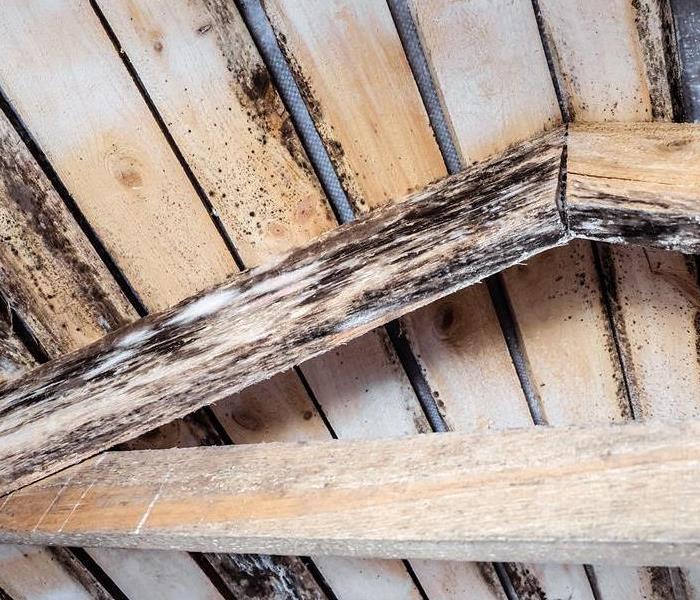 Preventing mold from growing in your attic is crucial for maintaining a healthy home.
Preventing mold from growing in your attic is crucial for maintaining a healthy home.
Mold is a common problem that can occur in attics and crawl spaces of homes. It can be unsightly, produce a musty odor. Mold thrives in damp and dark environments, which makes attics and crawl spaces susceptible to mold growth. Fortunately, there are several mold prevention tips that homeowners can follow to keep their attics and crawl spaces mold-free. In this blog post, we will explore some effective mold prevention strategies for attics and crawl spaces.
Keep Moisture in Check
The most important step in preventing mold in attics and crawl spaces is to control moisture. Mold needs moisture to grow, so it's crucial to keep these areas dry. Inspect your attic and crawl space regularly for any signs of water leaks, condensation, or dampness. If you notice any issues, address them immediately to prevent mold growth. Fix any leaks in the roof, walls, or plumbing, and ensure that gutters and downspouts are working properly to divert water away from your home.
Improve Ventilation
Proper ventilation is essential for preventing mold in attics and crawl spaces. Without adequate airflow, moisture can become trapped and create a conducive environment for mold growth. Install vents in your attic and crawl space to promote air circulation. Roof vents, soffit vents, ridge vents, and gable vents are common types of vents that can be installed to improve ventilation. Additionally, make sure that your attic and crawl space vents are not blocked by debris or insulation.
Insulate Properly
Insulation is another key factor in mold prevention. Insulate your attic and crawl space properly to reduce condensation and prevent moisture from entering these areas. Use insulation materials that are resistant to moisture, such as closed-cell spray foam insulation or rigid foam insulation. Avoid using cellulose or fiberglass insulation in areas that are prone to moisture, as they can absorb water and promote mold growth.
Monitor Humidity Levels
Monitoring humidity levels in your attic and crawl space can help prevent mold growth. The ideal humidity level for these areas is below 50%. Use a hygrometer to measure the humidity levels and invest in a dehumidifier if necessary to keep the humidity in check. Make sure to empty the dehumidifier regularly and clean it to prevent mold growth inside the unit.
Keep the Area Clean and Dry
Regular cleaning and maintenance can go a long way in preventing mold in attics and crawl spaces. Keep these areas clean and free from debris, dust, and dirt. If you notice any signs of mold, such as black spots or a musty smell, clean it immediately using a mold cleaner or a mixture of water and detergent. Dry the area thoroughly after cleaning to prevent moisture from lingering.
Use Mold-Resistant Products
When renovating or building a new home, consider using mold-resistant products in your attic and crawl space. Mold-resistant drywall, insulation, and paint can help inhibit mold growth and provide an extra layer of protection against mold. These products are specifically designed to resist moisture and prevent mold from taking hold in your attic or crawl space.
Seek Professional Help
If you are unsure about how to prevent mold in your attic or crawl space, or if you suspect a mold problem that is beyond your control, it's best to seek professional help. Mold remediation experts can assess the condition of your attic and crawl space, identify the source of the moisture, and provide appropriate solutions to prevent mold growth.
In conclusion, mold prevention in attics and crawl spaces is crucial for maintaining a healthy home environment. By keeping moisture in check, improving ventilation, insulating properly, monitoring humidity levels, keeping the area clean and dry.
Smoke Damage in Your Building: What You Need to Know
5/1/2023 (Permalink)
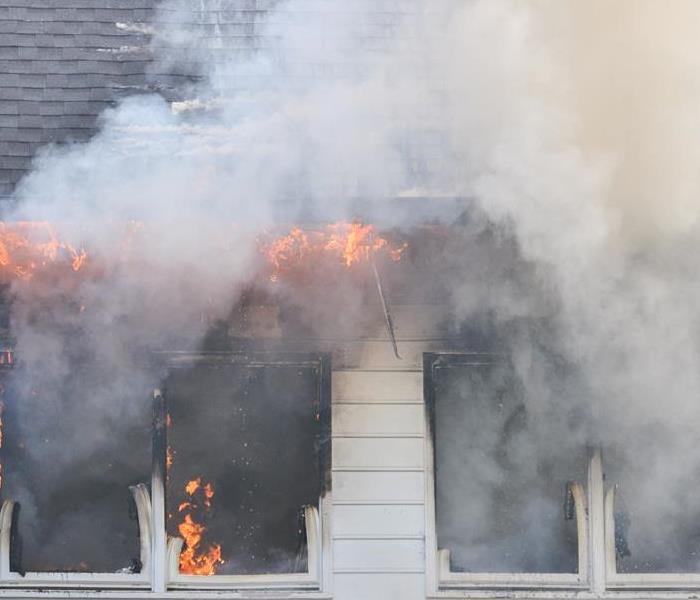 If your building experiences smoke damage, give SERVPRO a call today.
If your building experiences smoke damage, give SERVPRO a call today.
Smoke damage is a common issue in buildings, especially in those that have experienced a fire. Smoke can cause a wide range of problems, from discoloration and staining unpleasant odors. If you are a property owner or a tenant, it is important to understand what smoke damage is, how it can affect your building, and what you can do to prevent and remediate it.
What is Smoke Damage?
Smoke damage is the result of smoke particles that settle on surfaces in your building. These particles are microscopic and can penetrate deep into materials such as walls, carpets, and furniture. Smoke damage can cause discoloration, staining, and corrosion, and can also produce unpleasant odors that are difficult to remove.
How Does Smoke Damage Affect Your Building?
Smoke damage can have a number of negative effects on your building. First, it can compromise the structural integrity of your property. Smoke particles can penetrate deep into materials, weakening them over time. This can lead to cracks, warping, and other issues that can be costly to repair.
Finally, smoke damage can reduce the value of your property. Smoke stains and discoloration can be unsightly and difficult to remove, making your building less attractive to potential tenants or buyers.
Preventing Smoke Damage
The best way to prevent smoke damage is to take steps to prevent fires from occurring in the first place. This includes ensuring that your building is up to code with respect to fire safety, including installing smoke detectors, fire extinguishers, and sprinkler systems.
In addition, it is important to educate occupants of your building on fire safety and prevention. This includes providing training on how to use fire safety equipment, as well as emphasizing the importance of not smoking indoors or leaving cooking appliances unattended.
Remediating Smoke Damage
If your building has experienced smoke damage, it is important to take steps to remediate it as soon as possible. This may involve hiring a professional cleaning service that specializes in smoke damage remediation. These professionals will use specialized equipment and cleaning products to remove smoke particles and odors from your building.
In addition, it may be necessary to replace or repair damaged materials such as carpets, furniture, and walls. This can be costly, but it is important to address smoke damage promptly in order to prevent further damage.
In conclusion, smoke damage can be a serious issue for building owners and tenants. By taking steps to prevent fires and educating occupants on fire safety, you can reduce the risk of smoke damage in your building. If your building has experienced smoke damage, it is important to take prompt action to remediate it in order to prevent further damage.
A water leak could cost you thousands
3/7/2023 (Permalink)
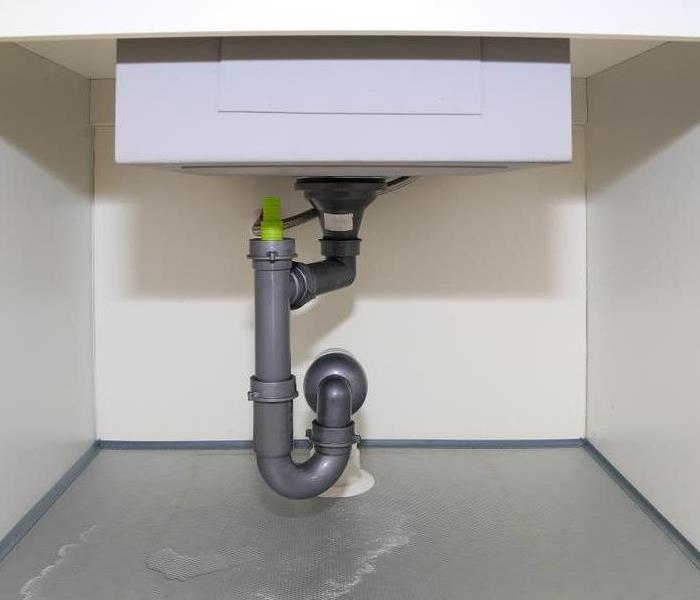 If you suspect a leak, give SERVPRO a call
If you suspect a leak, give SERVPRO a call
Water leaks are a serious issue for homeowners. They can lead to costly repairs, damage, and wasted water. You may think that you have a small drip somewhere in your house, but if the problem is not fixed promptly it could become something much bigger than you ever imagined.
Water leaks can go undetected for a long time.
Water leaks can go undetected for a long time. If you suspect a leak, call the professionals to help detect where the leak is coming from. Water leaks can cause extensive damage and waste thousands of gallons of water annually, leading to costly repairs and damage.
A water leak can lead to costly repairs and damage.
Water damage is not always obvious, and a small leak can cause significant damage over time. A water leak is the most common cause of mold in homes. When you have a leak in your home, mold can grow on walls, ceilings and floors, this can lead to secondary damages that could add up along the way as well. It may also cause structural issues in your home if left untreated.
Water leaks are often caused by aging plumbing systems as well as worn out faucets/taps. There are other ways that leaks could sneak up on you, including leaking pipes damaged by other construction or just normal wear and tare of the pipes themselves.
A leak wastes thousands of gallons of water annually.
If you have a leak, you are likely wasting thousands of gallons of water annually. A small drip can add up to hundreds of dollars in wasted water over time. A small drip is an obvious ones, but there are plenty more places where leaks can occur and go unnoticed until they're too late.
If you suspect a leak, contact your plumber immediately.
If you suspect a leak, contact your plumber immediately. Don't try to fix it yourself. To find the source of a leak, a plumber will use special tools and techniques. They can use water pressure gauges that measure how much water is flowing through pipes. Ultrasonic devices that send out ultrasonic sound waves and then measure how long it takes for the sound to bounce off different parts of your plumbing system. This allows them to detect leaks easily, even if they're hidden inside walls or floors or behind cabinets or appliances. Electromagnetic induction testers that detect electrical currents in metals like copper pipes so you can tell if there's any corrosion on them which can lead to a leak.
If you suspect that you have a leak, it is best to contact a plumber immediately. Leaks can be hard to find and may go undetected for months or even years. The sooner you get them fixed, the better off you'll be! Give SERVPRO a call if your home has suffered a water loss due to a water leak.
Causes of Fires in Healthcare Facilities
2/5/2023 (Permalink)
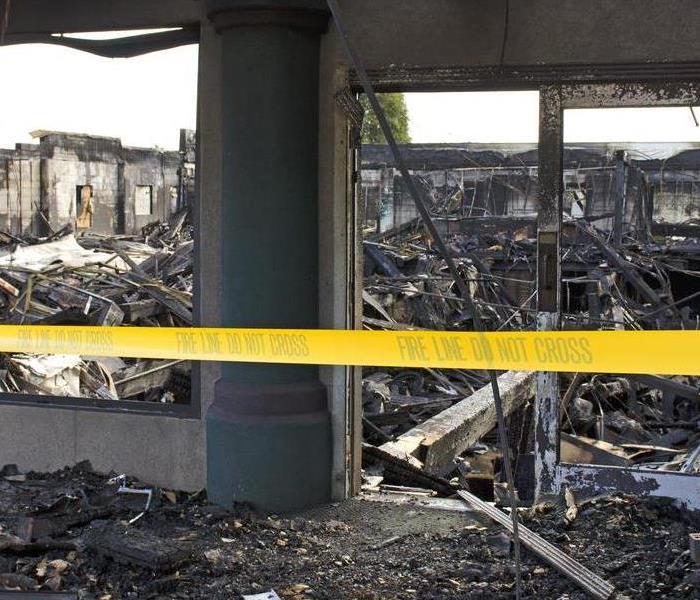 Fires in healthcare facilities can be caused by a variety of factors.
Fires in healthcare facilities can be caused by a variety of factors.
Fires in healthcare facilities are an unfortunate fact of life. These fires can be caused by a variety of factors, including improperly stored or used oxygen, drugs and alcohol abuse by staff members and visitors, cooking equipment left on unattended overnight or during breaks, electrical issues related to poorly maintained wiring systems or faulty equipment.
Improperly Stored or used Oxygen
Oxygen is used in hospitals for medical purposes. The most common uses of oxygen include, storage of oxygen in tanks or cylinders, use in medical equipment such as nebulizers and use during medical procedures such as laser surgery or cataract operations.
Flammable Substances
Hospitals store a wide variety of drugs, both prescription and over-the-counter. Many of these medications are highly flammable and can be ignited by sources as small as a cigarette lighter or even an electrical ignition source such as a defibrillator. Alcohol is another potential fire hazard because it is a solvent that can ignite on contact with an open flame or spark. In addition to these materials being stored at the hospital's pharmacies, they may also be used in areas such as operating rooms and emergency rooms to treat patients before surgery begins or after it has been completed.
Smoking
Smoking is a leading cause of fires in healthcare facilities. A combination of common causes such as matches, lighters and candles may ignite tobacco products left unattended, or even smoldering cigarettes left in ashtrays.
Staff and visitors are prohibited from smoking within all patient rooms, common areas and patient parking lots, including waiting areas with signs at entrances that state: "No Smoking". The prohibition also extends to balconies where patients may be treated outdoors.
Cooking Equipment
Because cooking equipment is used in healthcare facilities to prepare food for patients and staff, fires can occur when cooking equipment is not properly maintained or used. For example, a hot plate may be left unattended on a countertop while the staff member who was using it goes to another room to complete another task. In this case, if the hot plate isn't turned off or put away properly after use and left unattended, it may start a fire if someone comes along later and touches it while it is still hot.
Cooking equipment also needs to be stored properly so as not to pose any danger of starting a fire. In addition, staff members need training in how to avoid any unnecessary exposure to heat sources such as heating elements in stoves or microwaves.
Chemicals and Solvents
Chemicals and solvents are used in healthcare facilities for a variety of purposes. They can be found in cleaning products, medical equipment, and even some medications.
However, chemicals and solvents can also be hazardous if they catch fire or if they are not stored properly. If you work with dangerous chemicals or solvents at your job, it's important to know what makes these materials so dangerous when exposed to heat sources like flames or high temperatures.
Electrical Issues
Electrical issues are the leading cause of fires in healthcare facilities. Electrical issues can be caused by faulty wiring, overloaded circuits, and improper use of extension cords. They might also be caused by equipment that is not properly grounded to protect against electrical shock or electrocution hazards.
Electrical problems can result from damaged or worn out electrical cords, plugs and/or sockets, loose connections, damaged insulation, worn out wires, loose screws holding switches together with the panel box (also known as a junction box). Overloaded circuits due to adding new lights without upgrading wiring service and ungrounded outlets installed in wet areas where water may seep into a receptacle's ground prong area because of poor installation practices or conditions such as excessive moisture accumulation within an enclosure.
It’s important for hospitals and healthcare facilities to have a plan in place for fire safety. It should be part of the facility’s disaster management plan, and it should include regular inspections and maintenance checks on fire suppression systems, sprinklers and alarms.
How to Get Your House Ready for High Winds
1/10/2023 (Permalink)
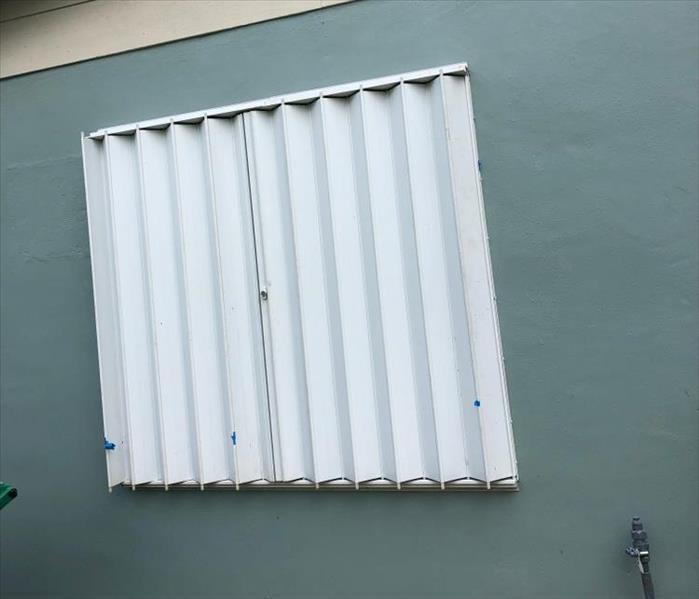 Storm shutters are the finest way to secure your windows.
Storm shutters are the finest way to secure your windows.
Preparing Your House for High Winds
When the weather gets windy, we all know that it can be dangerous. But did you know that high winds also pose a serious risk to your home and family? In fact, according to FEMA (Federal Emergency Management Agency), nearly half of all tornado-related deaths are caused by flying debris—and 90 percent of those deaths occur in homes. That's why it's so important to take the necessary precautions ahead of time to ensure your home is ready for these potentially deadly storms.
Clean Up the Yard
To secure your home, you’ll want to remove all loose items from your yard. This includes:
- Trampolines
- Decorative tree ornaments (such as lights and ornaments) that aren’t securely fastened to a tree trunk or other solid surface
- Excessive lawn furniture (like the massive patio sets) that could be blown away by high winds
Remove any dead or dying branches and cut back any branches that are overhanging the house from all trees in your yard. Also, trim back any branches that are touching the roof of your home, as this can cause damage to your roof in high winds. If you have a tree in close proximity to power lines, it is important that you do not trim those limbs because they could come into contact with those power lines and cause an electrical hazard. Finally, make sure not to trim back a tree near a swimming pool if there are children playing around it!
Secure Windows
The best way to secure your windows is through storm shutters. If you don’t have storm shutters, you can board up your windows with plywood to prevent flying debris from damaging the window. Another alternative could be window clips. Although these are not as secure as plywood or shutters, they are a good option for a limited time. Window clips can be purchased at most hardware stores and will do wonders for preventing damage to your home when the wind kicks up. They're easy to install, so there's no reason not to do it!
To secure the plywood with nails, hammer in a nail near each corner of the window or door. Then, pull out the nail and move over 1/4 inch and hammer it back down again. Repeat this process until all four sides of the window are covered with nails. To secure plywood using screws, use a screwdriver to drive two small screws into each side of the plywood that faces inward toward your house (this could be between siding boards).
Reinforce the Doors
You can reinforce your doors with weather strips and door sweeps. Weather strips are made of rubber and stretch across the opening where the door closes, sealing out air and moisture. Door sweeps are similar but have a metal band attached around them to help keep out water and other debris.
Both products come in different sizes to accommodate any type of door, so make sure you measure your frame before purchasing new ones (you may need to look for a custom-sized model). Once they're installed on your doors, they're not that hard to clean or maintain—simply wipe them down occasionally with a damp cloth if they get dirty or dusty. And if you live in an area where hurricanes are frequent, take extra care because these two items will be exposed to high winds!
Brace your Garage Doors
You can install a 2x4 to brace the garage door. The 2x4 should be placed horizontally on top of the door and secured with rope or chain.
To properly brace your garage door, you will need:
- A large wooden board (a 2×4)
- Two small wooden stakes
- Rope (or chain)
Prepare your Roof
To prepare for high winds, you'll want to make sure that your roof is in good shape. First, remove any debris from the roof. This can include leaves and other plant particles (as well as insects) that may be caught up in the gutters or on the surface of your home's exterior walls.
Next, check over any areas where repairs have been made and ensure they're still secure by fastening them again if needed. Check for leaks around pipes or vents; these are especially common areas for water intrusion during storms.
High winds can cause extensive damage to your home. You may be able to save thousands of dollars in property damage and medical bills by taking some simple steps to protect your home from high winds.
Why is it important to protect your home from high winds?
If you follow these tips, your house will be ready for the storm! If you do experience storm damage, give SERVPRO of Affton/Webster Groves a call! We will get your Crestwood, MO home back to normal in no time.
Mold Remediation After a Flood
12/14/2022 (Permalink)
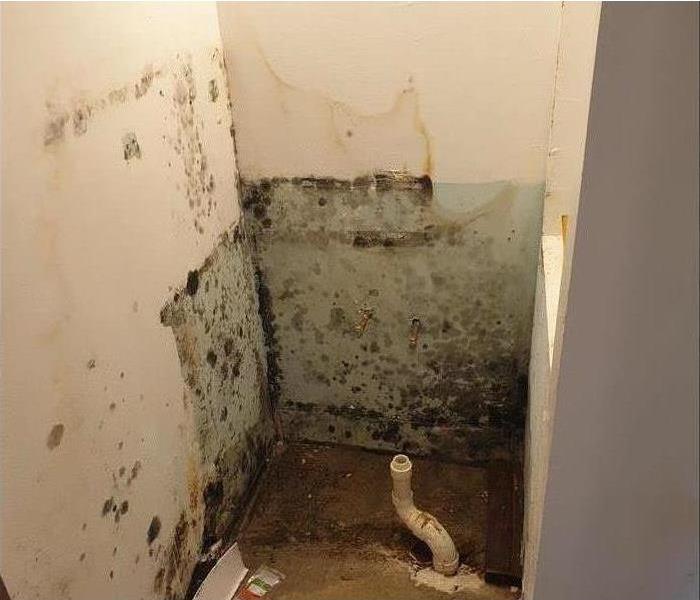 Mold cleanup is only one call away
Mold cleanup is only one call away
When you have a flood, it's important to get the water out of your home as quickly as possible. But that's just the first step—you still need to deal with any mold growth that was caused by the flood. We've put together this guide on how to remove mold after a flood in order to help you recover quickly and safely after your disaster.
Protect Yourself
When you're at an Affton, MO home or office after a flood, it is important to wear long sleeves, pants and gloves to protect your skin. You should also wear goggles when cleaning up any standing water in order to protect your eyes from dust particles. Note that your socks and shoes will likely have mold growing on them after being exposed, so be sure to take those off before entering mold free areas. You may also want to consider wearing a respirator mask if there are high levels of airborne particles that can be inhaled into the lungs (such as after a flood).
Check Thoroughly for Mold
You will need to check thoroughly for mold. Mold can grow in tiny, hard-to-see places. Be sure you are checking all throughout the house to ensure you don’t miss any:
- Check the backs of cabinets.
- Look in hidden areas like behind the refrigerator, under sinks and in crawl spaces.
- Check for mold in hard-to-reach places like behind a wall or under the floorboards.
- Do not neglect to check for mold on your walls and ceilings if you have water damage from a flood or leaky pipes.
Get Ready to Clean
After the flood, you’ll want to start cleaning up as quickly as possible. Mold can grow at an alarming rate and soon spread throughout your home in ways that are difficult to contain.
A good scrubbing brush or sponge will help remove mold from surfaces such as drywall or plywood. Use hot water mixed with detergent to clean these areas thoroughly, paying special attention to any stains where water may have been trapped for a long time. If possible, wear gloves and protective clothing (like long sleeves) so that you don’t come into contact with any mold spores yourself during the cleanup process! If you do end up getting some on your skin, wash it off immediately with soap and water before it has a chance to get into your system through open cuts.
Goggles should also be worn when dealing with any kind of cleanup project inside—these keep your eyes protected against airborne particles without obscuring vision too much for safety reasons! A respirator mask is recommended if there's more than just light dusting around (more than 1/4 inch thick).
Dealing with Porous Materials
You'll have to decide what to do with your porous materials. Porous materials like wood flooring, drywall, or ceiling tiles that have been wet for more than 48 hours should be thrown away. You can clean and dry carpets within 24 hours—but if you have carpeting it is important to get it cleaned as soon as possible (within 24 hours) so that mold does not grow in the fibers of your carpet.
It's important to take care of any mold growth in your house as soon as possible. If left alone, mold will continue to grow and spread throughout your home—so it's crucial that you remove it quickly and completely. If you suspect that you have a recurring issue with mold growth or if there is a history of flooding in your area, consider hiring an expert to check up on your home regularly. Your professional should be able to find any signs of water damage or potential sources for future leaks (such as faulty plumbing) so they can be repaired before they cause further damage.
Now that you know how to deal with mold, you can put the power in your hands to prevent it from growing on your property. Remember that prevention is key when dealing with this issue because once you have a mold problem, it’s difficult to completely get rid of and may take months or even years before it goes away completely. When you have a serious mold problem in your home or business, the best course of action is to call SERVPRO of Affton/Webster Groves!
What To Do About Water in Light Fixtures
12/1/2022 (Permalink)
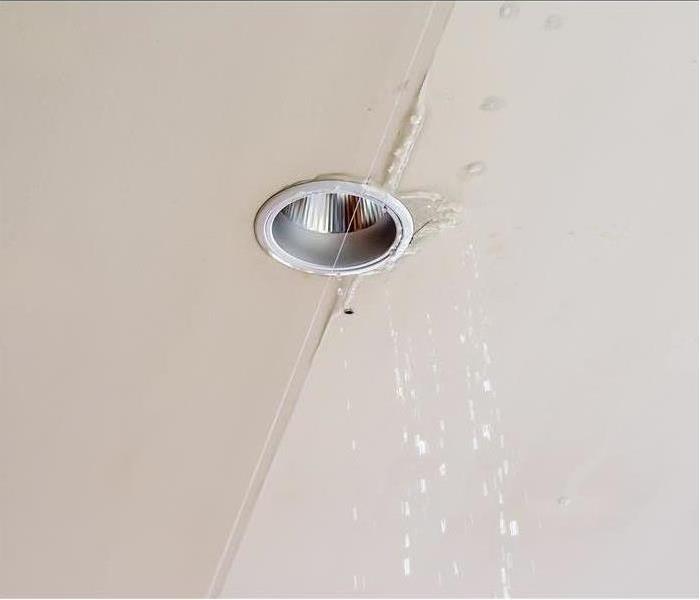 Water in light fixtures often indicates larger problems with your home's roof or plumbing
Water in light fixtures often indicates larger problems with your home's roof or plumbing
What To Do If This Occurs In Your Home
Water damage can manifest in a variety of ways, including water in light fixtures. The following steps outline what to do if this occurs in your Affton, MO, home.
1. Disconnect the power and water. This step is crucial for ensuring your safety. Go to the breaker box and cut off the power to the area of the house where the water-damaged light fixture is located. Do not touch the fixture or light switch until the power is off. Next, turn off the primary water valve. If you are able to locate the main valve inside the home, cut off that one. It should be on the side of the house facing the street. If you cannot find that valve, go outside and turn off the water at the valve near the meter. The meter and valve are usually located under a metal panel near the street.
2. Address the source of the water and dry the property. When the power and water are off, you can work on preventing more damage from occurring. The ceiling damage that leads to water in light fixtures generally occurs as a result of a pipe or roof leak. You may have to tarp over the roof or call a plumber for help fixing a pipe break. If there is standing water, dry it up using a wet/dry vacuum, pump or buckets. A certified restoration service can help with drying out standing water, but it is important to act quickly to avoid further damage and mold growth.
3. Call an electrician. Hire a professional electrician to replace the light fixture. They have the skills to do this safely. Do not turn the power back on and do not work on the light fixture yourself.
Water in light fixtures often indicates larger problems with your home's roof or plumbing. Fortunately, there are professionals, including electricians and plumbers, that can help you with all of these issues.
How To Prevent Water Damage To Your Home
11/12/2022 (Permalink)
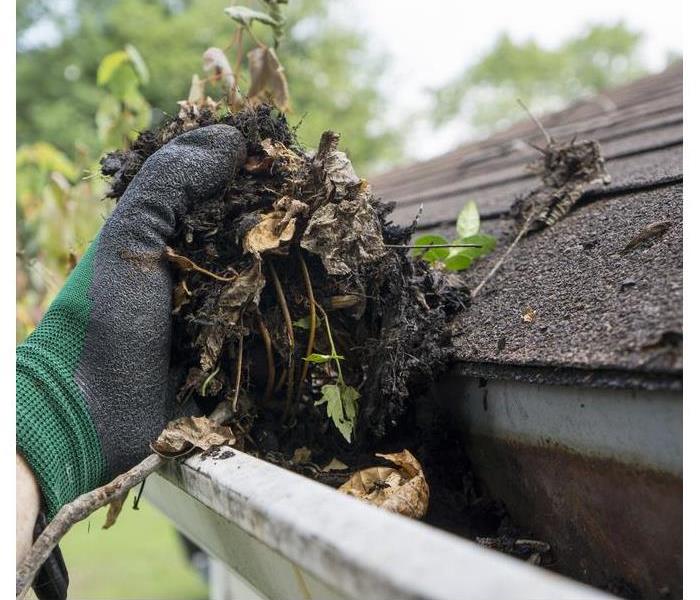 Keep rain gutters clear
Keep rain gutters clear
How To Protect Your Home From Water Damage
Water damage is a serious problem that can lead to mold and mildew growth, as well as costly repairs. In some cases, it can even be dangerous if it goes unchecked for too long. Thankfully, there are things you can do to prevent water damage in your Webster Groves, MO home. By following these tips and being mindful of your surroundings, you will be able to keep your home safe from any unwanted moisture problems:
How Can Water Damage Affect Homes?
Water damage can cause serious problems in your home. The effects of water on your home's structure, as well as the mold that grows after this damage has occurred, are very serious and can lead to costly repairs or even complete replacement of the damaged areas.
Water can quickly cause electrical issues in your house. In some cases, electricity may have been running through an area before it was flooded with water, causing short circuiting or other electrical issues. This could pose a fire hazard or even be fatal if there is no way for you to get out of the house once trapped inside due to malfunctioning doors or windows which cannot open properly thanks to water damage.
Keep Rain Gutters and Downspouts Clear
A clean and secure gutter system should be your first line of defense against water damage. Cleaning gutters regularly will ensure there are no tree branches, leaves or other debris that could become lodged in the downspout. If you notice a buildup of dirt or grime on your roof, it’s time to clean your gutters.
If you have clogged or damaged gutters, water can leak into your home through both corners that meet at an angle (called valley joints). In addition to keeping them clean and free of debris, it’s also important to have any broken sections repaired immediately so they don’t lead to leaks later.
Do Not Leave Dishwashers or Washing Machines Running When You Are Not Home
If you leave the washer or dishwasher running while you are not home and something goes wrong, it will cost thousands of dollars to repair the damage. You may think this is an unlikely scenario, but it happens more often than you think. Many people have experienced massive flooding in their homes because they left their washing machine running empty or did not properly secure their dishwasher door when they were done with a load of dishes. The best way to prevent this from happening is by following the simple rule that if any appliance has water flowing through it when you leave your house, turn off the water supply before leaving so nothing can leak out during your absence
Check Pipes and Hoses For Cracks or Leaks
You can do this by turning off the valve at the meter or basement floor and looking for drips or pools of water. You should be able to hear a leak, but if you can't then try placing a dish towel where you suspect there might be one and wait for it to absorb any moisture that may have gathered there. If it does, then you know that's where your leak is. If not (or if there isn't any moisture), then turn on the faucet; if no water comes out after 10 minutes of waiting, then check all places where pipes could possibly lead into the walls (ex: behind toilets).
Check your heating system once every month during winter months so that you're ready to fix broken parts before they cause bigger problems down the road!
Check Around Your Water Heater
A leaky water heater is usually the first sign of a water problem in your home. It's important to check around your water heater and look for signs of water on the floor underneath it. If there is no drain, it's possible to create one by drilling a hole into an exterior wall, running PVC pipe through it, and connecting it to an existing drain.
If you find that your tank is leaking or cracked, then replacing just the tank may be enough. However, if this doesn't solve the problem then repairing cracks in pipes using epoxy can also work well.
When To Call a Professional
- When the damage is too extensive.
- If you are not sure what to do.
- If you are unsure of the source of the water.
- If you are not sure how to fix it.
It’s important to avoid water damage in your home as much as possible. If you notice any leaks or signs of water damage, call a professional immediately.
3 Easy Tips to Prepare for a Storm
11/1/2022 (Permalink)
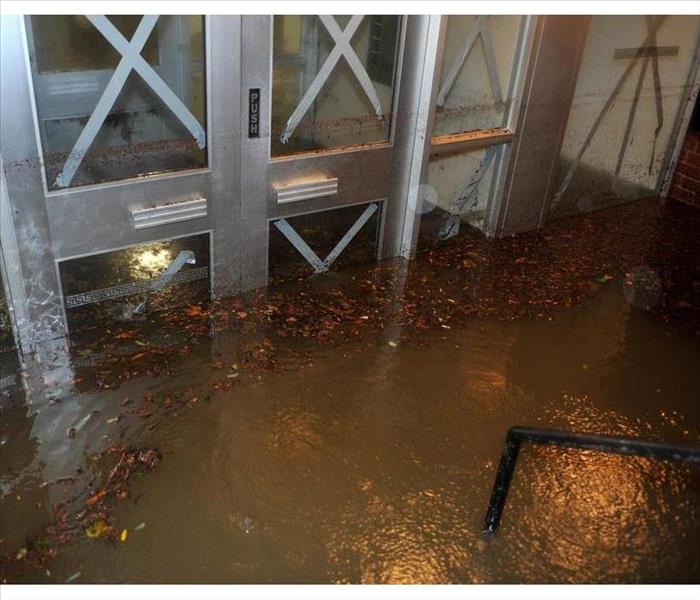 Flooded business in Lakeshire, MO.
Flooded business in Lakeshire, MO.
Prepare For a Storm
Some storms can pass with little to no impact, while other storms may be utterly devastating. If you’re about to be hit with a storm that may flood water into your home, it’s important that you prepare for it. The more prepared you are, the less your home will be impacted by water damage and the less your flood specialist will have to deal with.
1. Protect Against Flooding
You can take on this first step before there is any sign of a storm. It’s preferred that you flood-proof your home before there is a problem with flooding. First, you can make sure that your basement and walls are sealed with a waterproofing compound to give it a defense against the flood. Second, if you know that a storm is coming, you can construct barriers to stop the flood water from getting into your home.
2. Protect Yourself and Your Belongings
If a flooded building is imminent, then it’s time to be prepared for the water. First, you need to make sure that your valuables are on higher ground. If you have an upper floor, move your valuable items there. Additionally, you should make sure that all of your utilities are turned off from their main switch and disconnect all electrical appliances. When there is a flooded building, it’s possible that water could cause an electrical situation if these items are left on.
3. Pack an Emergency Kit
If you know that there is going to be a flood, it’s possible that you will only have to deal with the pain of water removal once the storm is over. However, in more serious scenarios, you may be required to evacuate. Always have an emergency kit with extra clothes packed and kept dry away from the flood.
Flood water can strike anywhere, and it can strike anyone. You should never be underprepared when dealing with the prospect of water damage in Lakeshire, MO.
What To Expect After a Partial Fire Loss
10/11/2022 (Permalink)
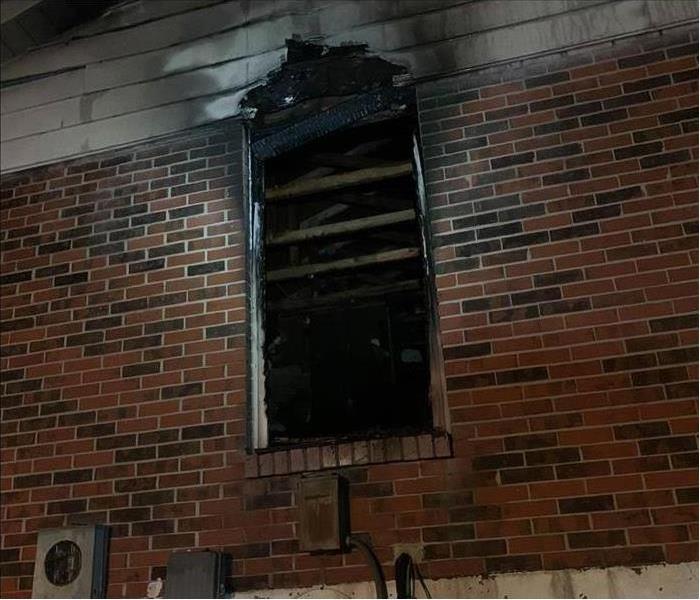 Exterior fire damage
Exterior fire damage
What to Expect Following a Minor Fire Loss
When your facing a partial loss, it can seem like the entire world has fallen apart. However, this is not always the case. In many cases, partial losses can be addressed in a way that will get your life back to normal quickly and easily. You just need to know what to expect after a fire or another disaster happens in your home or business.
Size Matters
While partial losses do not have to cause as much damage as a total loss, they still cost money and time to fix. Why? Because they are often more expensive than a single replacement item would be if you were not suffering from a partial loss. For example, if your car is damaged in an accident and the door needs replacing but not the entire vehicle, you will likely have to pay significantly more for this service than if you had purchased just one new door instead of having it repaired at all.
A partial loss can take longer than expected to fix because there are multiple parts involved in any given repair job—and each part may need replacing before proceeding with the next step in fixing your home or business property after it's been damaged by fire or floodwater. This means that even though part of what makes up your building might still be OK after being flooded out (say because only one room was affected), it's gonna be harder work getting everything back together again once everything has dried out enough so that repairs can begin properly.
Before the Disaster
You should come up with a plan for when disaster strikes. Your plan should include information about how you will exit your home, where everyone is going to meet up after they leave their homes, and phone numbers of local shelters or hotel options in case everyone needs somewhere else to stay until the damage from the fire is cleared away (if this is possible). Make sure everybody knows what kind of clothing they need for different weather conditions as well as whether or not pets are welcome at these shelters or hotels.
You should also create a checklist of what items need to be taken out first during an evacuation so that when things get hectic there will still be time left over at the day's end for everything else—including saving some money on insurance premiums by making good decisions now.
Take Action Quickly
Partial loss fire restoration can be a stressful process. However, it's important to remember that there are many steps you can take to speed up the process and make sure your home is restored as quickly as possible.
Ventilation is key in a partial loss situation, as smoke damage will occur if the area isn't properly ventilated before any work begins on restoring the property.
Once you've decided whether or not it's safe for your family or pets to return home (or if they should stay somewhere else), ask your property manager about how long it will take for repairs to be completed so that you can plan accordingly. If there's damage from flooding, it's best to wait until after all repairs have been made before moving back into your house; this will allow any mold present in your walls time enough to dry out without being exposed again by living within those walls at a high humidity level day after day.
Insurance Coverage
Insurance companies generally pay for certain types of repair work when it comes to water damage restoration, so it's important that you know what kinds of repairs they cover, but they don't cover everything. For example, if there are any items missing from your home after a flood or sewage backup (such as furniture or appliances), then the insurance company may not be responsible for those losses unless they were specifically listed on your policy as being covered by the policyholder at no extra cost. Similarly, if some parts of your house have been damaged by mold growth during this time period then those costs aren't typically covered under most policies either since mold growth is considered an "act of nature" which usually isn't included in most standard forms within homeownership programs in particular situations like these ones.
A partial loss can be a scary thing, but it doesn’t have to be. If you take the right steps and do your research beforehand, then you can minimize the damage that comes with these kinds of fires. When you experience a loss - partial or whole, SERVPRO of Affton/Webster Groves is here to help restore your St. Louis home or business.
3 Steps To Creating a Viable Continuity Plan for Your Business
10/1/2022 (Permalink)
 Having a business continuity plan in place can help you get back to business as soon as possible.
Having a business continuity plan in place can help you get back to business as soon as possible.
Three Steps to Developing a Workable Business Continuity Plan
When a water disaster impacts your Grantwood Village, MO business, one major concern you may have is how the damage is going to affect your customers and employees. A work stoppage can have a significant impact on your business and cause you to lose time, money, and clients. However, having a business continuity plan in case of a flood or other disaster can help you be better prepared and reduce downtime, and there are a few steps you can take to create this plan.
1. Understand Your Needs
Before you can create an emergency response plan that works for you, it is important that you understand which facets of your business are the most important in case of a flood and where you would put your focus first. Creating a business impact report might help you address these needs and allow you and your managers to follow a unified plan in case of a disaster.
2. Create a Strategy
Once you understand your company’s needs when it comes to preventing or reducing a work stoppage in case of an emergency, it is important that you identify strategies that may help you fulfill them. Consider factors such as what financial resources you might have to make repairs and what kind of recovery options you might have at hand. Review these with your managers, and work to close as many resource gaps as possible.
3. Organize Teams
Creating effective teams to manage a work stoppage can be an important aspect of any business continuity plan. Because there are many facets to managing this issue, having informed teams organized and ready to react to an emergency can be vital to getting your company up and running again as soon as possible.
When your Grantwood Village, MO business experiences a disaster such as a flood or fire, a work stoppage can seriously impact its success. Having a business continuity plan in place can reduce this type of disruption and help you get back to business as soon as possible.
Storm Damage Versus Flood Damage
9/22/2022 (Permalink)
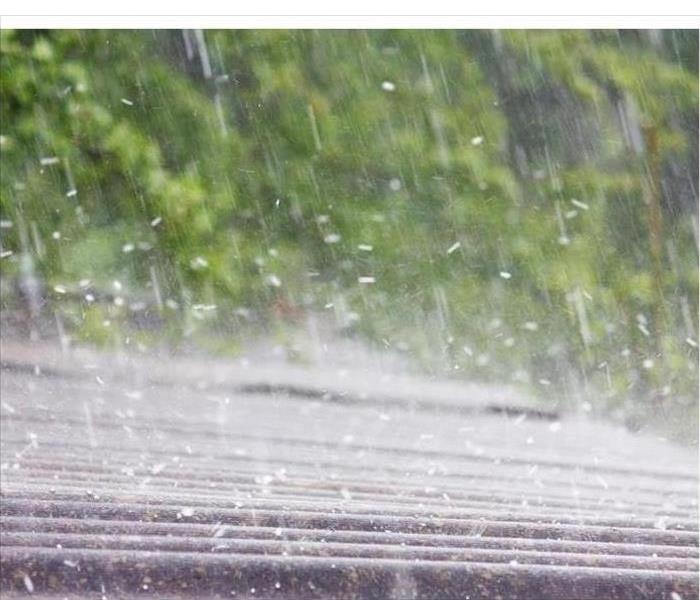 Hail storm
Hail storm
Storm Damage Versus Flood Damage
You might not see a huge difference between storm and flood damage, but your insurance company sure does. It's absolutely vital to make sure that your Shrewsberry, MO, business is covered for both types of damage. Getting to know the ins and outs of your specific insurance policy can help prevent you from suffering thousands of dollars in property damages.
Damage Defined
Differentiating between the two types of damages can be tricky. Insurance companies typically label the accident as storm damage if the destruction was a result of one or more of the following:
- Heavy rainfall
- Cyclones or tornadoes
- Hail storms
- Hurricanes or other tropical storms
While it is absolutely possible for the above incidents to cause flooding, your insurance company won't see it that way. Ever since the Queensland floods in 2011, the Insurance Code of Practice has defined flood damage as "the covering of normally dry land by water that has escaped or been released from the normal confines of any lake, river, creek or other natural watercourse, whether or not altered or modified, or any reservoir, canal or dam."
How to File a Claim
If your commercial building is covered, then you need to file your insurance claim as soon as possible.
Contact your insurance company to report the damage.
Separate your damaged property from your undamaged property. Don't throw anything away until your insurance agent has inspected it. Take plenty of photos of the damage as well.
Create a list of damaged items inside the building. Take photos and provide standard information, such as the items' models, serial numbers, and brand. If you still have any receipts or bills, include them in the report.
List any structural damage that you want the insurance adjuster to notice. As always, take plenty of photos.
Both severe storms and floods can cause massive amounts of water damage, but your insurance company still treats them like separate accidents. Make sure to contact remediation experts if your commercial building has recently suffered from storm or flood damage.
4 Things You Should Know About Mold Growth
9/12/2022 (Permalink)
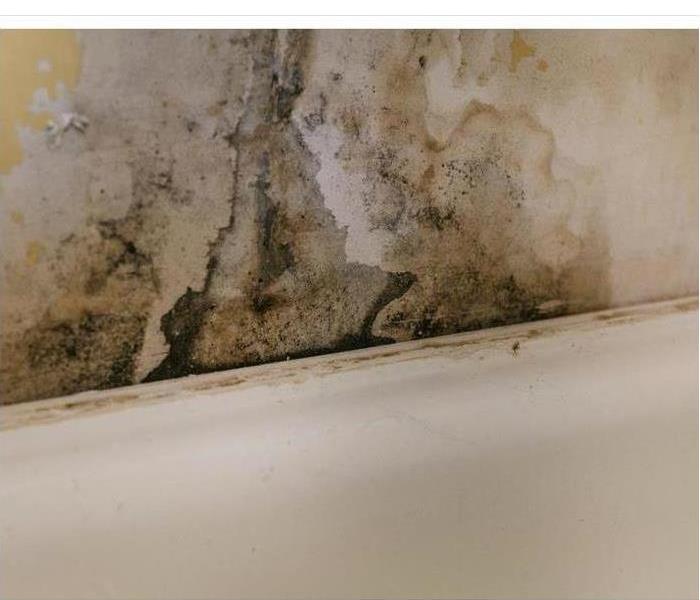 Mold damage in Affton, MO
Mold damage in Affton, MO
Things To Know About Mold Growth
It is not unusual to find mold growth in an Affton, MO, building. However, there are some things about this common problem that you may not know. The following information may be helpful if you find yourself with an infestation.
1. What Is Mold?
Mold is a fungus that needs moisture to grow. There are many varieties, so the appearance of the growth can range in color and texture. You may find green, black or orange mold in your building, and it might be fuzzy, slimy or powdery depending on the particular type.
2. Where Does Mold Come From?
This fungus is spread via mold spores which are too small to be seen with the naked eye. They often travel on air currents or on shoes and clothing. Mold is present in many environments but does not usually cause any trouble unless high humidity or another moisture problem creates the right conditions for growth.
3. How Do You Know if You Have Mold?
You may not always be able to tell right away if you have mold growth in your building. If it is located in an area that is difficult to see, the first sign might be a musty odor. In other cases, it can show up as a discoloration on surfaces such as walls and flooring. If you find mold or suspect that it may be growing, a mold damage remediation company can perform an inspection to locate and remove it.
4. Can You Prevent Mold?
The good news is that mold can usually be prevented by keeping moisture levels low. One way to do this is to have any water damage repaired as quickly as possible, whether that is something severe like flooding or a seemingly small issue like a leak. Dehumidifiers can also be helpful if there is a lot of moisture in the air.
In most cases, mold growth is no reason to panic. It is usually harmless and can be removed with the help of a professional. Taking steps to prevent it from growing or returning can limit the damage that it causes.
Fire Damage Event in Your Home
9/1/2022 (Permalink)
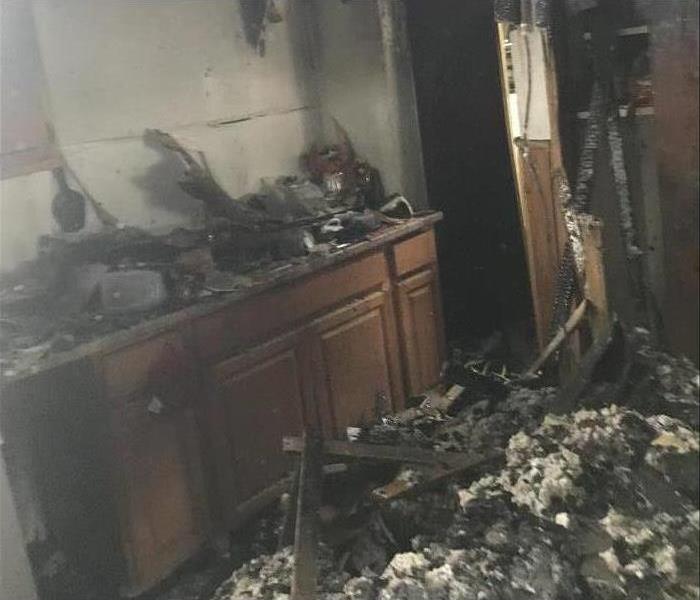 Fire damage in a home in Shrewsbury, MO.
Fire damage in a home in Shrewsbury, MO.
As restoration specialists with extensive experience in handling house fire damage, the professionals of SERVPRO are aware of the difficulty for you to cope with the trauma of a conflagration. It's important to be prepared when a fire strikes your home in Shrewsbury, MO. The following list can help you decrease stress, increase personal safety and limit damages.
During a Fire When At Home
1. Check Your Doors Before You Open Them.
Before you open your doors, look under them to determine if any smoke is being emitted. In the event that there is smoke, move to another door for exit. If you don't see any smoke, make sure that you place the back of your hand against the door before opening it. A very warm door indicates that the fire may still be in full effect. If there are no doors through which you can safely exit the home, try a window.
2. Exit The House
As soon as you realize fire is taking place, you need to get out of the house. Although you may want to grab personal belongings that are of sentimental or monetary value, consider safety first.
3. Do A Head Count
After you and your loved ones have exited the home, make sure all the family members are safely out.
After a Fire
4. Call The Red Cross, if necessary
The Red Cross will direct you to a safe place where you can find food and shelter for the night. This is an option that hopefully, you will not need.
5. Call Your Insurance Agent.
Your insurance agent will send out an adjuster to evaluate the fire damage. Also, inquire if your insurance company has a working relationship with SERVPRO. Hundreds of insurance agencies and property management companies do have SERVPRO on their speed dial, and a quick phone call can dispatch a fire damage restoration expert to your home within the hour. A careful assessment, inventory documentation, and action plan can already be initiated.
6. Don't Reenter Your Home.
Be sure not to go back into your living space until you've been cleared by the local fire department.
7. Compile Important Documents.
Get all of the important records and documents you can find together. Take computers and laptops for digital records.
8. Keep Receipts Of "Disaster Expenses."
Make sure that you're keeping records of any expenses you incur due to the disaster.
Getting You Back Home
The team from SERVPRO will offer outstanding customer service. You will always be in the loop as to the progress of the fire damage restoration progress in your Shrewsbury, MO home.
Why Does My House Have Mold?
8/20/2022 (Permalink)
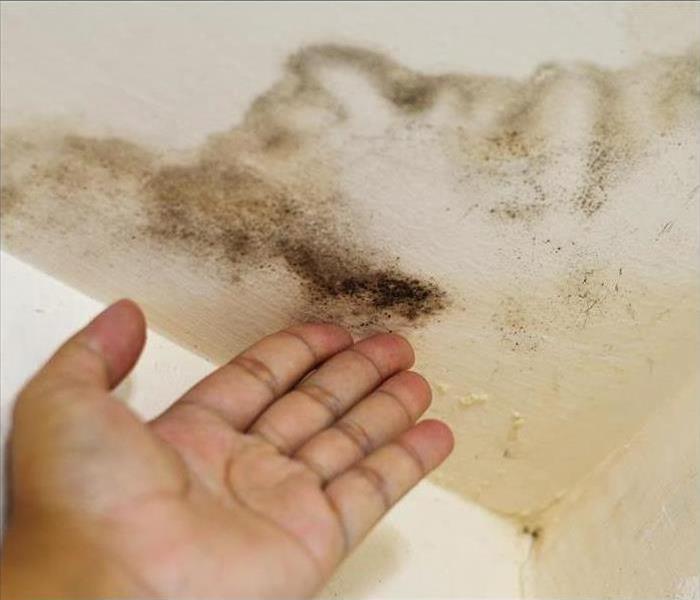 Mold damage in Crestwood, MO.
Mold damage in Crestwood, MO.
Why Is Mold Growing In My House?
The moment you get a whiff of a musty odor, you know your home in Crestwood, MO, has a mold problem. When that happens, it best to have a black mold remediation and restoration do the mold cleanup to ensure it is done properly. While it’s good to know someone is there to make it “Like it never even happened,” avoiding an infestation altogether is ideal.
Common Culprits
The key ingredient for any type of fungi issue is a moisture problem. Mold needs moisture, warm temperatures and food, which are various organic materials in your home, to survive, thrive and grow. Below are some of the main culprits that quickly lead to a black mold problem:
Humidity: As moisture evaporates, it increases the humidity levels inside your home. Your clothes dryer and HVAC system often play key roles in that increase.
Leaks: A hidden leak, even if it is a small drip, means water is pooling somewhere and dampening materials. Along with pipes, roofs are a common area for undetected leaks.
Condensation: From cold metal pipes to concrete floors and windows, varying temperatures increase the chances of condensation and mold.
Ventilation: When air isn’t circulating properly, it may mean a missed spill takes longer to dry or aid in increasing humidity levels.
Wet Clothes: Most of your clothing has organic fibers. As the water sits, it creates an ideal locale for fungi to grow.
Damp Basement: The lower level of your home often lacks good ventilation and has higher levels of moisture in the air. Since water follows gravity, leaks on other floors may naturally lead right to the basement.
Prevention Tips
Any unexpected moisture that lingers longer than 24 hours means you are increasing the chances of a colony growing and spreading to other areas. While mold isn’t entirely preventable, keeping humidity levels below 55%, immediately fixing leaks, insulating pipes and windows, running a dehumidifier, and ensuring good airflow are easy and cost-effective ways to minimize the chances of dealing with a massive problem.
Avoiding black mold means knowing common areas it is found and taking measures to keep those areas as moisture-free as possible.
Business Insurance Is a Lifesaver When Recovering From Water Damage
8/15/2022 (Permalink)
 Business insurance policies alleviate tension from financial costs and massive restoration projects.
Business insurance policies alleviate tension from financial costs and massive restoration projects.
Three Reasons To Invest In The Policy
When saturation impacts commercial property, an owner may feel lost and exasperated trying to pick up the pieces. The premises are in danger of developing mold, rot and structural deterioration; thus, the exposure and lingering water damage demand prompt and methodical care to ensure the establishment in Webster Groves, MO, can reopen, free of hazards. Business insurance may be the lifeline needed to stay in operation and survive the repairs.
1. Receive Necessary Financial Support
Proprietors may face complete building overhauls. Remediation includes tearing out walls and flooring, purifying the air and vent system and tending to the source of trouble. The entire space must be disinfected and dried. These tasks add up to thousands of dollars, which owners may not have immediate access to. Many insurance policies cover the harm broken pipes caused. Owners pay a deductible amount; insurance, then, fronts the cost for everything else (within the coverage range). Also, merchandise and electronics may be harmed. Personal loss coverage allows for a check to replace or salvage these items.
2. Secure Authorized, Certified Assistance
Water damage treatment isn't easy, and inadequate cleanup could lead to future complications and additional bills. The insurer insists on proper methods, including the hiring of a reputable, certified water remediation company. The experts hold IICRC credentials, national professional standards, which layout a framework for meticulous care. In addition, Commercial Drying Specialists investigate the impacted sections. These workers have taken additional classes to understand the best processes to dry and sanitize the space. They can organize an effective plan and determine which technology to use to air out the area.
3. Enjoy Backup Reviews
Water cleanup errors or missteps could permit mold to grow or structures to fail. The insurer looks over the bills, damages and estimates to see that all necessary steps occur. An extra set of eyes is support to avoid more issues.
Business insurance policies alleviate tension from financial costs and massive restoration projects. Having it to help with water damage is an absolute must.
What To Do When Your Fire Alarm Is Beeping
8/2/2022 (Permalink)
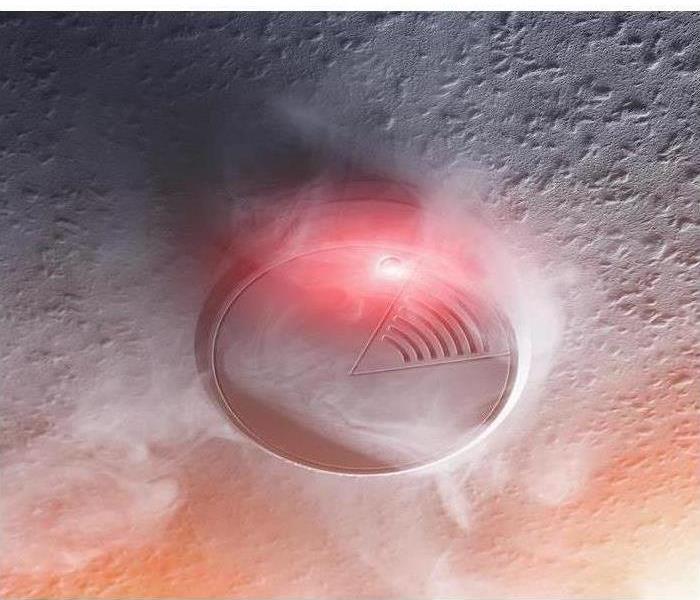 Your smoke alarm is an important part of your home.
Your smoke alarm is an important part of your home.
What To Do If Your Fire Alarm Goes Off
When you hear your fire alarm beeping, your first instinct should be to check for smoke or flames in your Affton, MO home. If you do find a fire, get out of the house and call 911. Once the blaze has cleared, you should also contact your local fire damage cleanup specialists.
If there is no fire, your next course of action should be figuring out why your alarm was beeping.
Typically, a beeping smoke detector in the absence of fire signals that something is wrong with the detector itself. You need to make sure the device is working properly so it will alert you in the event of a real fire.
After all, a working smoke detector could give you a chance to extinguish the blaze before it causes severe fire damage. If your fire alarm is beeping when there are no flames, follow the below steps.
Reset the Device
Just like other electronics, a smoke alarm can be reset. Try turning off its power source, removing it from its bracket, and pressing down the test button for 15 to 20 seconds.
Change the Batteries
If you want to avoid the need for major fire cleanup in your home, you should change your smoke detector batteries every six months. Before taking the old batteries out of the device, be sure to note how they are placed in the alarm.
Clean the Alarm
Dust inside a fire alarm can also cause it to beep uncontrollably. The dust could also cause the detector to malfunction when there is actual smoke damage in your home. You can solve this issue by using an air blower to remove any debris.
Buy a New Device
If all else fails, consider buying a new smoke detector. Any alarms more than 10 years old should be replaced.
If you hear your smoke alarm beeping when it shouldn’t, you need to address the source of the malfunction as soon as possible.
Tips for Drying Water Damage
7/20/2022 (Permalink)
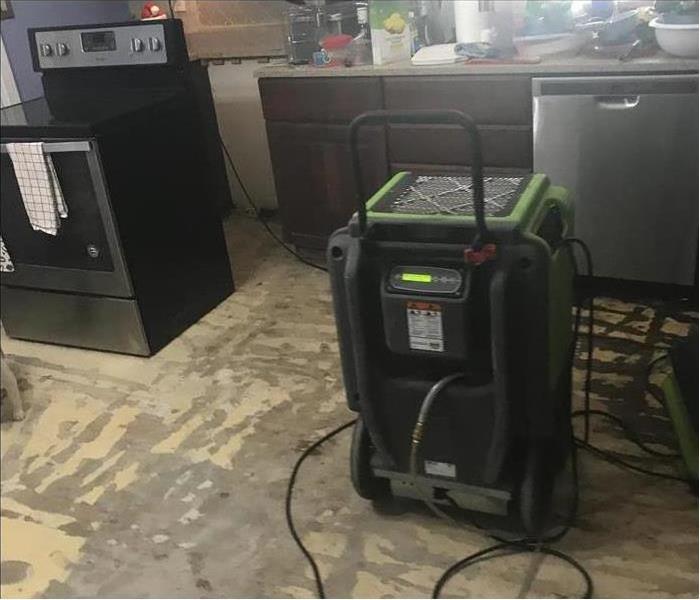 A dehumidifier helps remove the water in your home by evaporating water in the area.
A dehumidifier helps remove the water in your home by evaporating water in the area.
Removing Water Damage
Water in your home or water in your business should be dried as quickly as possible after water damage has been assessed. Here are a few different ways you can try drying out after flood damage though you may want to hire an experienced water damage restoration company. Water cleanup can be harder than you think.
Drying Quickly
Mitigation of your water damage should be complete within 48 hours if you want to salvage your goods while avoiding mold and rust. If you're in an area that has low humidity, Start drying immediately by opening all the windows and doors to help with with air movement. Also, over all the closets and cabinets and all the drawers.
Dehumidifier
A dehumidifier helps remove the water in your home by evaporating water in the area. When you start using the dehumidifier close all the windows and doors. Since this will reduce air movement, you should find a couple of powerful fans capable of higher rates of air movement and place them throughout the area.
Removing Standing Water
A pump can be purchased to aid in water cleanup. If flood damage has left a large amount of water in your business, that water damage can be minimized if you work quickly. Mitigation can continue with a wet/dry shop vac. You can suck up water on the floor and even aid in the drying process with it.
Getting Rid of the Trash
Water damage causes many of your belongings to become ruined. You will have to remove all these objects during your water cleanup process can begin. Water damage restoration can't be completed until the drying is complete. Remove wet furniture and rugs to an area where they can get the sun and natural air movement. Remove any vinyl flooring that was victim to flood damage. Make sure you dispose of wet insulation as well.
Go With a Professional
Water damage and flood damage can be combated with silica gel packets that absorb moisture. Water damage restoration companies will be more efficient at removing water in business settings. Make sure that you contact someone right away.
Mitigation of both your water damage restoration project and water cleanup project can be taken into your hands, but it is smarter to hire a professional who has experience removing water in homes and water in businesses. If you don't do the job well enough, your house may end up being uninhabitable. Mitigation of the project should begin as soon as possible.
3 Things to Look for in a Water Damage Restoration Company
7/11/2022 (Permalink)
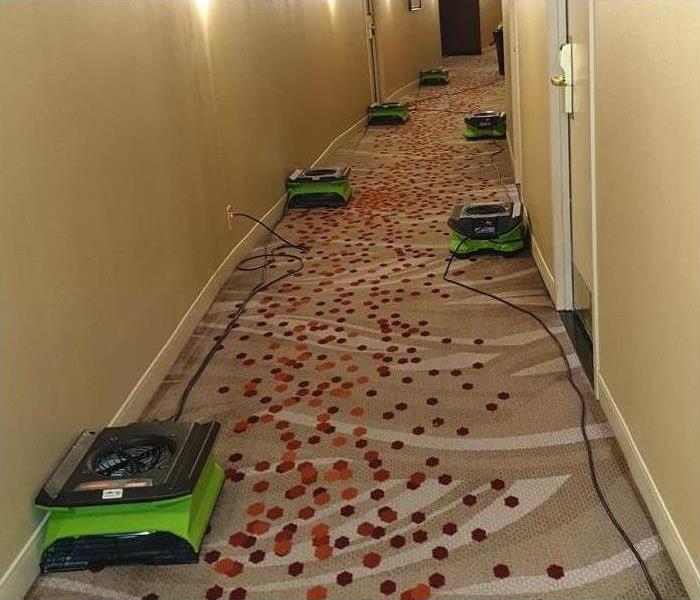 Commercial water restoration in a building in Crestwood, MO.
Commercial water restoration in a building in Crestwood, MO.
Commercial Water Damage Restoration
It can be devastating to discover water damage in your property. You need to act quickly to get a professional out to your property to address the broken pipes immediately. Hopefully, you already know of a water cleanup company in Crestwood, MO to lend a helping hand, but if you do not, then here are some qualities to look for in an organization before you spend any money:
1. Insurances, Licenses, and Certifications
You do not want to hire anyone to work on your commercial building who is not accredited and certified to work in your state. Certification proves the contractor has acquired the necessary documents and has gone through training to clean up the damage concisely. Insurance is critical in case someone ends up suffering an injury on your property. If the water damage restoration company does not have insurance, then you could be liable and have to pay medical bills out of your own pocket.
2. Proximity
Time is of the essence when it comes to addressing flooding in your commercial building. You should hire a mold remediation company that can come out quickly because it only takes 24 hours for mold to begin to develop. Additionally, addressing the damage is sure to increase the likelihood of being able to restore valuables.
3. Experience
You do not want to address flooding in your building on your own because you likely do not have the supplies necessary to remove water. You also do not know how to properly repair damaged structures, such as drywall. The same principle holds true for the water damage remediation company in Crestwood, MO you hire. Always ask a contractor about the number of years he or she has worked in the industry. Hire someone who has been involved in this line of work for years as opposed to someone who just got a license.
How to Prevent Freezing Pipes
7/2/2022 (Permalink)
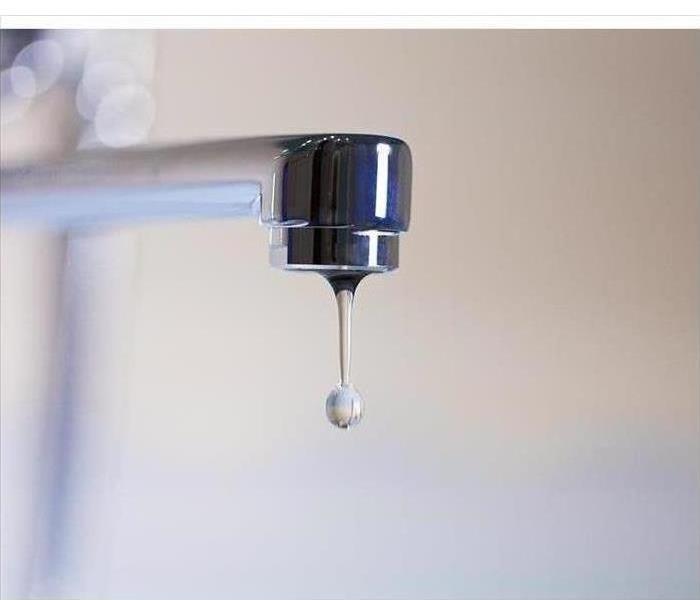 Allow your faucet to drip.
Allow your faucet to drip.
Avoid Frozen Pipes
Imagine hundreds of gallons of water flooding into your home. Frozen pipes can lead to this disastrous scenario due to the pressure that freezing water puts on a pipe that can’t expand; pressures can rise to over 2,000 pounds per square inch. So, pipe freeze prevention is crucial when you live in a climate that sees temperatures reach 20 degrees or below. Avoid frozen pipes by:
1. Letting Faucets Drip
If temperatures are expected to drop to 20 degrees or below, you should turn your indoor faucets on a slow drip. The constantly moving water keeps pressure from building up in the pipes.
2. Leaving Cabinet Doors Open
Every little amount of heat helps during extremely cold temperatures. Open cabinet doors to sinks to expose the pipes to the warmer air of the home. Also, leave the door open to any rooms that have plumbing but no air vents; these pipes are especially susceptible to freezing.
3. Wrapping Pipes
There are several ways to warm pipes. Electrical heat tape is the most effective method of pipe freeze prevention. It should be chosen for the most extreme climates. Thermostatically-controlled heat tape will automatically turn on when temperatures drop below a certain point.
4. Insulating Pipes
Foam insulation works well for more moderately cold climates. Foam insulation is easy to install; it’s usually just placed over the pipe.
5. Heating Unheated Areas
Unheated areas need to be heated to at least 40 degrees to keep pipes from freezing. However, portable heaters should never be left unattended, so it’s best to have a permanent heater installed.
6. Removing Hoses
Hoses that are attached to outdoor hose bibbs or sillcocks should be detached before the temperatures reach freezing. The water should be shut off to the faucet and the water drained.
Pipe freeze prevention is one of the most important proactive measures you can take during the cold weather months. If your Webster Groves, MO, home experiences a burst pipe, water damage cleanup experts can return it to its preloss condition.
Key Tips for Creating a Pet Fire Safety Plan
6/26/2022 (Permalink)
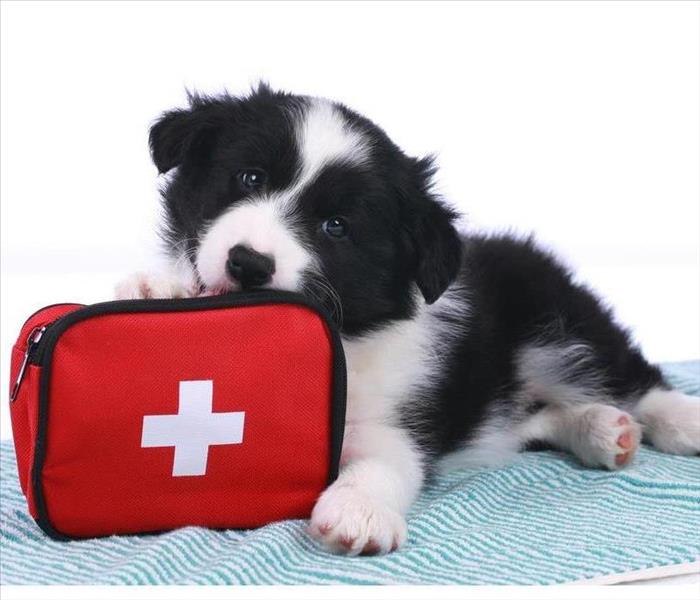 Your pets need their own emergency kit.
Your pets need their own emergency kit.
Creating a Pet Fire Safety Plan: Key Points
When there's a fire emergency, it can be stressful to get everyone to safety, including your pets. Therefore, it's essential to have a plan in place for not just your family's well-being but any four-legged friends as well. Here are some important tips for pet safety if a fire breaks out at your Webster Groves, MO, home.
Have Necessary Supplies Ready
Just as you would have emergency supplies like water, blankets and first-aid kits for humans, your pets need their own supplies as well. This includes:
- A stash of pet food
- Additional water
- Extra leashes, collars or other basic pet equipment
Keep these emergency items together in a safe space such as a car trunk in the event of a home fire.
Always Include Pets in Your Fire Emergency Escape Plan
Your pets are part of your family, so they should always be included in any emergency evacuation plans. Create an escape plan and practice evacuating with your family. During these practice drills, assign someone to take pets out of the home with them. Train pets to come when called to make evacuation easier.
Store Pet Documents Safely
When homes require extensive fire damage restoration services, oftentimes important documents are destroyed. Keep a fireproof box in your home with all your family's personal information documents, as well as pet documentation. Protect your pet's vaccination records and ownership papers as you would a passport or other personal documentation.
Prepare Alternative Shelter
If a fire displaces a family, their pets may not always be able to stay with them. An overlooked component of pet preparation is having an alternative shelter established in the event of a fire emergency. Ask a relative, friend or neighbor if a pet may stay with them under emergency circumstances.
Prepare to keep your pets safe in a home fire by having emergency supplies, practicing evacuation, storing veterinary documents safely and having an emergency shelter set up.
Our Newest General Manager!
6/21/2022 (Permalink)
 Congratulations to our newest General Manager, Steve Burgdorf!
Congratulations to our newest General Manager, Steve Burgdorf!
It’s time to announce our newest General Manager, Steve Burgdorf! Starting as a part-time employee over ten years ago, owner Kevin Thole says Steve has been instrumental to our mission and growth, rising through the ranks to his newest position.
In addition to his glow-up (featured above??), Steve has gained invaluable wisdom in the world of restoration and serving others. A typical day in the life of Steve includes showing up early and working late, solving problems and making sure operations run smoothly and efficiently. And while he’s great at those things, Steve’s favorite part of the job is helping people who have had their lives upended from property damage get back on their feet. There’s always something new, and the opportunity to see others reach their personal and professional goals gets Steve excited every day.
Steve is inspired by the positive and optimistic people around him — an optimism he also reflects — and relishes a challenge. Even when days are long and tough, Steve says that it is rewarding to know you’ve made a positive difference in people’s lives, and that makes everything worth it.
Thanks for all you do Steve! You’re a rockstar!
Stay tuned for an announcement regarding Steve’s other promotion this week!
Why You Should Avoid Drain Cleaners
6/14/2022 (Permalink)
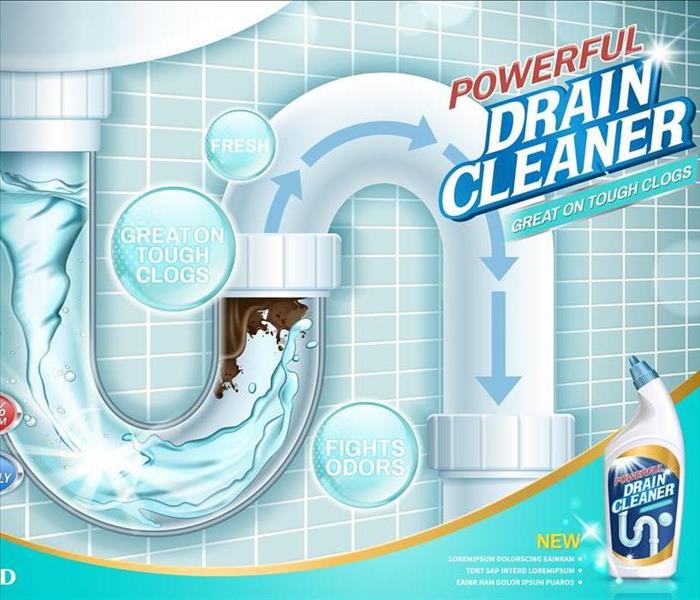 Many people turn to drain cleaners for clearing clogs.
Many people turn to drain cleaners for clearing clogs.
Drain Cleaners Should Be Avoided
Commercial properties often require the assistance of dedicated maintenance staff. The staff is responsible for maintaining all property components, including plumbing. A clogged drain is a common issue for maintenance staff, but not all employees treat the problem in the best way. Many people turn to drain cleaners for clearing clogs. Experienced plumbing professionals in Shrewsberry, MO, strongly advise against using such cleaners for several reasons.
1. Drain Cleaner Is Aggressive
Commercial cleaners are often more aggressive than necessary for breaking up clogs. The chemicals can wear down pipe surfaces, reducing the integrity of the system. Often, traditional sewage cleaning is a better solution than using cleaners. Augers and other tools scrub the pipe without damaging it.
2. A Cleaner Will Not Clear a 100% Blockage
A clogged drain can be partially blocked or completely blocked. A partially blocked pipe may be cleared using a gentle cleaner, but no cleaner will break through a 100% blockage. Instead, a maintenance or plumbing professional will need to use an auger or a drain snake. The snake physically digs into clogs, breaking them apart and removing them.
3. Cleaners Do Not Mix Well
Sometimes, people can get overzealous when trying to break up a clog. They may go through several cleaners, thinking one is better than the next. Unfortunately, mixing cleansers can present a safety risk. Mixing chemicals can lead to dangerous reactions, which can damage your plumbing further. If you want to try a cleaner for your drain, stick to using one product.
Often, a clogged drain is not a significant problem; an auger or drain snake can make quick work of it. However, using a cleaner for drains can make matters worse. Therefore, instead of trusting commercial cleaners, contact a local plumber and ask about the safest and best ways to clear a blocked drain.
Top 5 FAQs About Floods
6/2/2022 (Permalink)
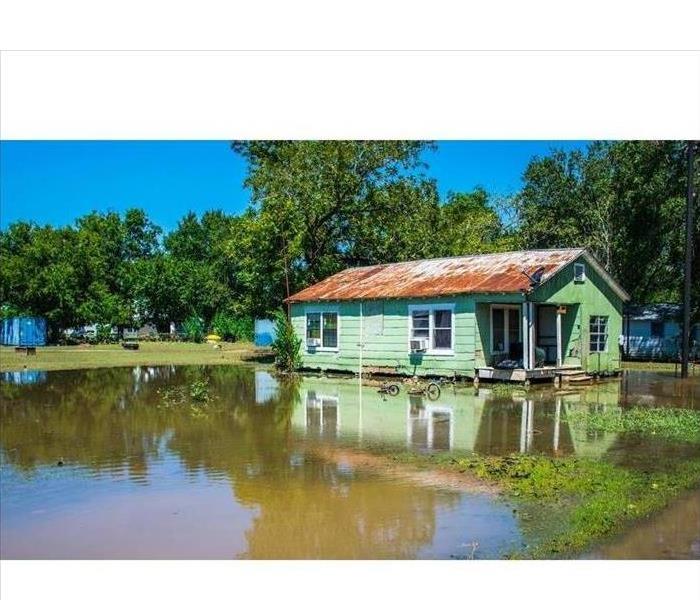 Home in Crestwood, MO located in a flood zone.
Home in Crestwood, MO located in a flood zone.
Common Questions Regarding Flood Risk
Floods are a relatively common natural disaster that many homeowners have to deal with at some point, especially if your home in Crestwood, MO, is located in a major flood zone. Read on to have your most common questions regarding flood risk answered.
1. What is a Flood Zone?
These are the areas that have the greatest risk of succumbing to a major flood in the event of a severe storm or natural disaster. There are multiple different levels, but it's still best to anticipate the worst, just to make sure you're adequately prepared.
2. How Do You Know Whether You're in a High-Risk Zone?
The easiest way to gauge your personal risk is to check the map provided by the Federal Emergency Management Agency (FEMA). There are several different maps provided, and each has its own unique information to offer regarding flooding.
3. How Can You Tell When a Flood is Coming?
The best way to stay informed is to sign up for an emergency broadcast alert system. NOAA Weather Radio All Hazards is just one of the many channels you should pay attention to in order to stay up to date on an incoming flood or storm.
4. How Can You Gauge Flood Severity?
The National Weather Service (NWS) has a list of flash flood warnings, categorized in order of severity. These warnings typically pop up through your emergency alert channels within approximately 6 hours of heavy rainfall or severe weather. The three major classes are "Base," "Considerable" and "Catastrophic."
5. Can Flooding Occur Anywhere?
Flooding can occur anywhere in the United States, no matter what time of year it is. Of course, there are certain seasons when floods are significantly more likely. These seasons can vary depending on where in the country your property is.
Knowing your property's specific flood zone can help you prepare to face any imminent storms. If your property does succumb to water damage, then you need to contact flood remediation experts as soon as possible.
Sewage Backup in the Bathtub? Follow These Steps
5/25/2022 (Permalink)
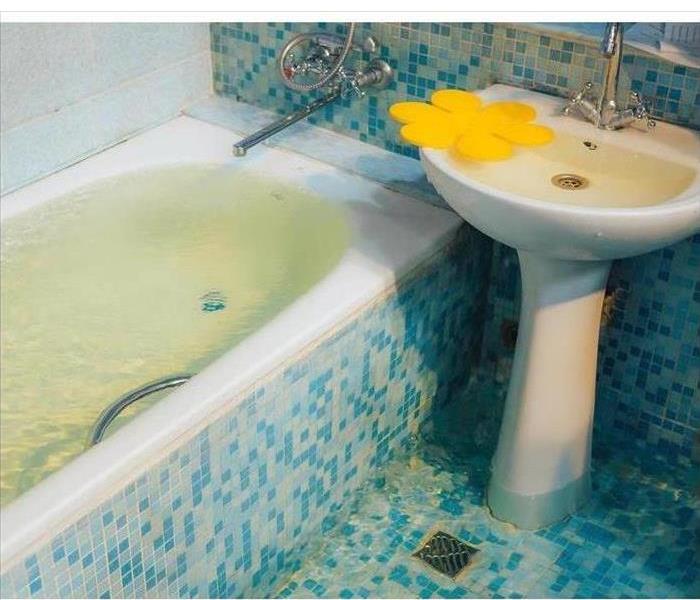 A sewer backup is a big problem that only gets worse if it isn't handled correctly.
A sewer backup is a big problem that only gets worse if it isn't handled correctly.
Bathtub Sewage Backup
Any type of bathroom flooding is a big problem, but sewer backup in the bathroom is an even bigger headache. Naturally, your best course of action is preventing the flood from happening in the first place, but that isn't always an option. Stay calm, and follow these simple steps if your home in Grantwood Village, MO, has recently experienced sewage backup in the bathtub.
1. Assess the situation: Sewer backup is a Category 3 water contamination, and a very dangerous biohazard. In some cases, it may not be safe to even enter the room or building where the flooding is. Before attempting to tackle the mess, always make sure the electricity is switched off and you're wearing the appropriate protective gear.
2. Don't make the problem worse: It's natural to want to continuously flush the toilet when the water won't go down. Do not do this. Instead, turn off all running water in the room. If a burst pipe is to blame for the flood, then switch off the water to the building.
3. Protect belongings in the room: Remove every single item in the room that has been contaminated by the sewage. This includes furniture, carpeting, shower curtains, and anything else that has come into contact with the water. Move these items outside where they won't cause further contamination. Open the windows and doors in the bathroom to help generate airflow into the room.
4. Call for professional help: Extreme bathtub backup might require professional assistance. Contaminated water can cause a lot of damage in a very small amount of time, so it's important to act quickly. Avoid personal contact with the sewage as much as you can, as the contaminated water can cause health effects.
A sewer backup is a big problem that only gets worse if it isn't handled correctly. Contact your local flood remediation experts in order to get the job done right the first time.
Electrical Fires and Your Business
5/18/2022 (Permalink)
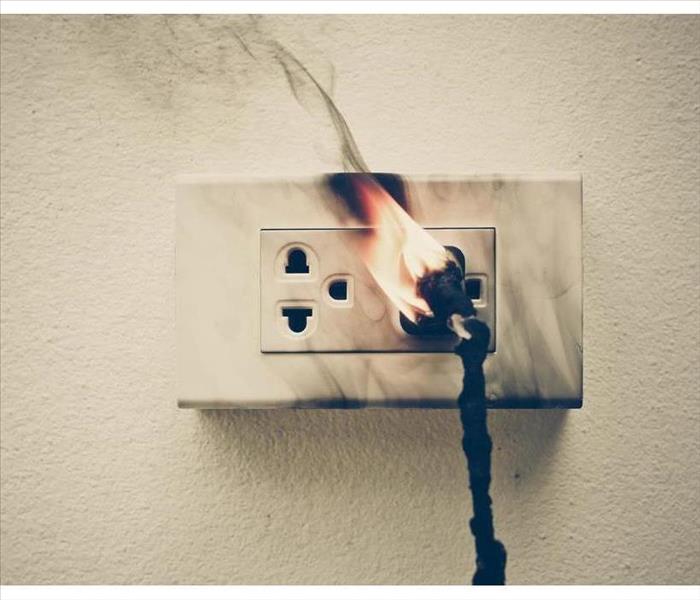 Electrical fire is a common cause of fire damage in commercial settings.
Electrical fire is a common cause of fire damage in commercial settings.
Common Causes Of Electrical Fires In Your Business
When it comes to sneaky sources of flames and property damage, electrical fire is one of the top culprits. Frayed wires, outdated electrical systems, damaged cable insulation, and short circuits are some of the top factors. The most common causes of these fires include
- Faulty electrical outlets and outdated appliances with damaged cords or switches
- Cords that have been run underneath a rug
- Light bulbs with a wattage too high for light fixtures
- Power and extension cords that have been overloaded
- Inappropriate placement of space heaters, especially when they are too close to combustible items
- Old wiring systems that can't handle today's reliance on electrical appliances
One of the best ways to protect your commercial property from electrical sparks and destructive flames is to recognize these common causes of fire and take preventative steps.
Which Extinguisher Is Best?
Another important step in protecting your property is to install appropriate fire extinguishers throughout your buildings. After an electrical fire, computer cleanup is much more effective if the right type of extinguisher has been used. There are several types to consider; the most common are
- Clean agent extinguishers, commonly used in rooms with a lot of computer equipment
- Class K extinguishers, are the best option for commercial kitchens where grease fires are a possibility
- Wet chemical extinguishers, most appropriate for hot surfaces, such as in foodservice establishments
- Dry chemical extinguishers, best used for minor blazes in industrial settings
After a fire extinguisher has been used, contact a fire cleanup and remediation professional to appropriately clean up the residue from extinguisher discharge and to inspect your computer equipment for fire and smoke damage. If computer equipment is damaged and you use it, further damages and even new fires could take place.
What Other Preventative Steps Can You Take?
Electrical fire is a common cause of fire damage in commercial settings. Take steps to protect your Lakeshire, MO, business by understanding the most likely scenarios and taking steps to prevent them. Make sure you have the right policies in place and install the most appropriate extinguishers for each room in your building.
Three Reasons To Hire a Certified Damage Restoration Specialist
5/13/2022 (Permalink)
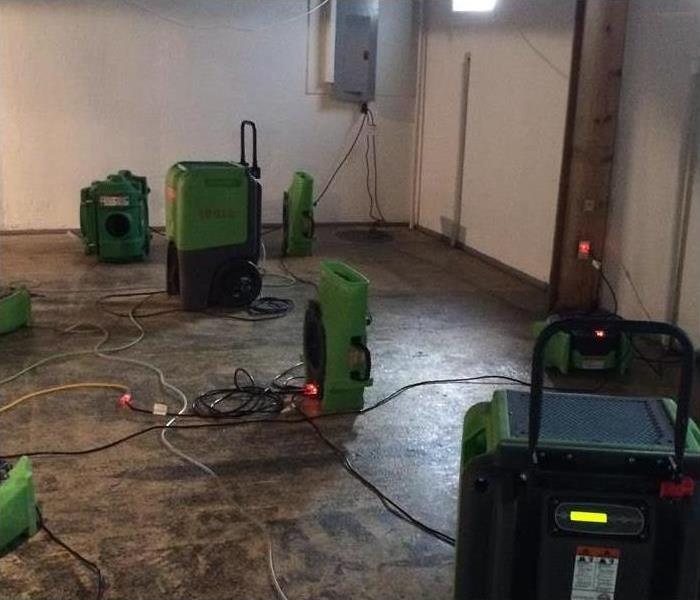 Drying equipment is placed to ensure all water is removed from the floor.
Drying equipment is placed to ensure all water is removed from the floor.
Three Reasons To Hire a Certified Damage Restoration Specialist
Whether you are dealing with a broken pipe, leaky roof, or flooding, a certified water damage expert can handle any type of water clean-up on a commercial property. You may find that specialists who have current certifications are able to resolve the problem quickly, limit secondary damage and that insurance companies are more likely to cover their work.
1. Certified Experts Handle Damage Quickly and Correctly
Restoration professionals with IICRC certifications, particularly the Commercial Drying Specialist certification, are capable of recommending the right methods for restoring a commercial property and contents to working order as soon as possible. This can help to minimize secondary damage and lost income.
2. Insurance Companies Prefer to Work With Certified Experts
When it comes to water clean-up, insurers can count on certified experts to get the job done. Certified specialists are also more likely to guarantee the quality of their work. If you do experience mold growth or other secondary damage following restoration, you may not have to foot the full cost of mitigation if you have followed the recommendations of a certified service.
3. Less Secondary Damage May Occur
Certified experts are aware of the risks of allowing water damage to linger. This can help to prevent secondary damage from starting to develop or becoming a severe problem. Mold can begin to grow in as little as 24 to 48 hours following water damage, so it is a good idea to get an expert on the scene as soon as possible.
Certified water damage restoration professionals have the expertise and equipment necessary to perform water clean-up. If you need to restore damage from a broken pipe or any other source in a commercial property in Shrewsbury, MO, look for a clean-up and restoration service that employs IICRC-certified experts.
How To Identify Black Mold
1/23/2022 (Permalink)
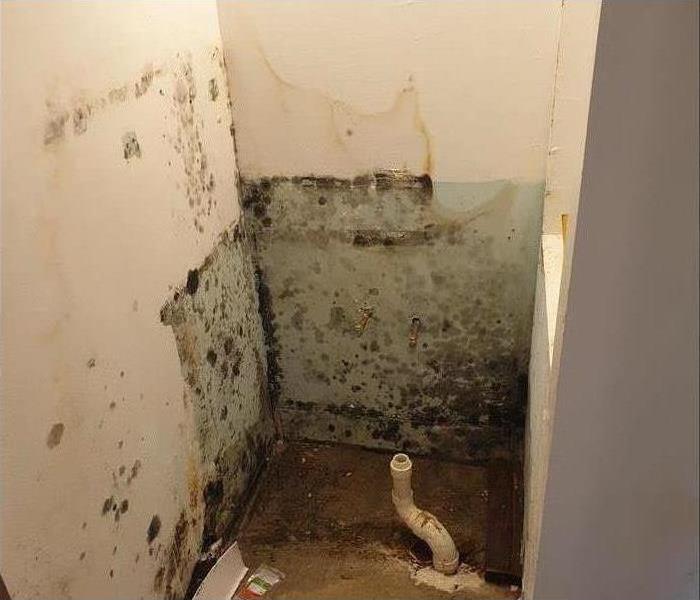 Mold contamination in a home in Crestwood, MO.
Mold contamination in a home in Crestwood, MO.
Assessing the Presence of Mold
Black mold or stachybotrys is one of over 100,000 different species of mold. This species can be difficult to identify visually, as it is not always black in color. An environmental hygienist should perform a mold inspection and analyze samples to determine which type of mold is growing at a residence in Crestwood, MO. Here are several guidelines for assessing the presence of mold.
Locate the Colonies
A homeowner may look for indications of house mold. Keep a few basic guidelines in mind:
- Do not attempt to cut holes in walls or disturb contents to find hidden mold
- Avoid touching or otherwise disturbing colonies, as this may release spores
- Note moldy odors, which may indicate the presence of mold
Mold releases microbial volatile organic compounds during its growth cycle. The musty odor is not necessarily caused by the presence of spores, but by off-gases.
Consider Colors and Growth Patterns
Mold may vary in color at different points in its growth cycle. This is one of the reasons why attempts to visually identify fungi may not be accurate, and a mold inspection is necessary. Stachybotrys may be dark green in color during the early stages of growth. This species is also not fuzzy and does not grow in geometrical patterns like some other species.
Hire an Environmental Hygienist
The best way to determine whether mold is present and identify the type of fungus is to have a specialist come to a residence and take samples. Depending on whether mold growth is immediately evident, a hygienist may take air samples to test for signs of mVOCs or spores to cultivate in a petri dish.
A mold inspection is the only way to obtain a definitive answer regarding whether black mold is growing in your home. Look for an environmental hygienist located in Crestwood, MO, or schedule a consultation with a full-service mold remediation company.
How Do Fire Sprinklers Work During a Fire?
1/16/2022 (Permalink)
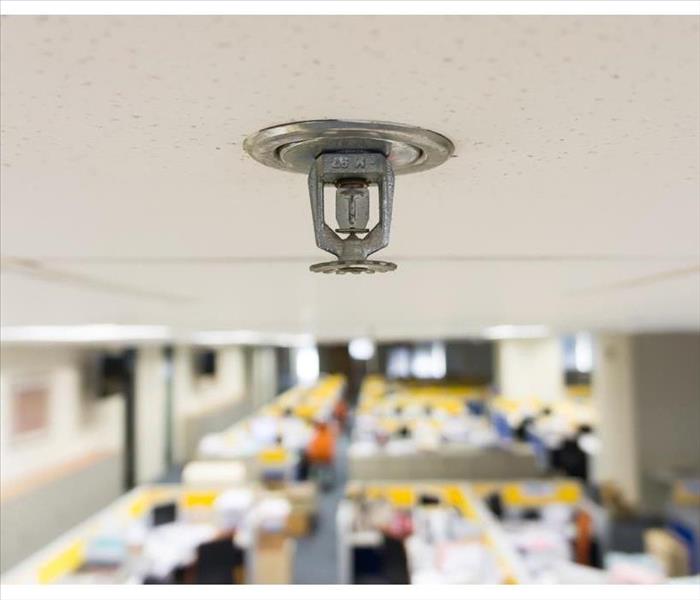 How do fire sprinklers work?
How do fire sprinklers work?
During a Fire, How Do Fire Sprinklers Work?
For many Webster Groves, MO, business owners, knowing that a fire sprinkler is installed at their commercial property provides great peace of mind. But how does a sprinkler actually work when a fire is taking place? Here are the steps involved in its operation and some other facts you may not know.
Sprinkler System Benefits
There are a great number of benefits to installing fire sprinklers in your building, including the following:
- They reduce the heat, smoke and flames present during a fire.
- They can minimize the risk of property damage.
- They often put out a fire before firefighters even have a chance to arrive at the scene.
Since a fire sprinkler system can save lives and reduce the risk of damage, it really does pay to have one installed at your place of business.
How Sprinklers Operate
A sprinkler system consists of a pipe network filled with pressured water. This network is installed behind your building’s walls and ceilings, with the exterior sprinklers placed along your piping system. If a fire should occur, the sprinklers close to the flames become activated by a high temperature - never by smoke. The pressure system allows the sprinklers to shoot out water in a forceful manner, leading to fire suppression and possibly extinguishing the flames completely.
Fire Sprinkler Cleanup
By now, it is likely that you are convinced of the many safety and financial benefits of installing a sprinkler system. But what about the destruction caused by all that water? Fortunately, a commercial fire restoration company can help. In addition to assisting you with loss from the smoke and flames, fire damage technicians can help you clean up any water damage that occurs as a result of the sprinklers. In some cases, even important documents can be dried or otherwise salvaged.
A fire sprinkler system will help you protect more than your property. It will assist you in ensuring the safety of you and your workers in the event of a commercial fire.
Is Your Home Ready for a Storm?
1/7/2022 (Permalink)
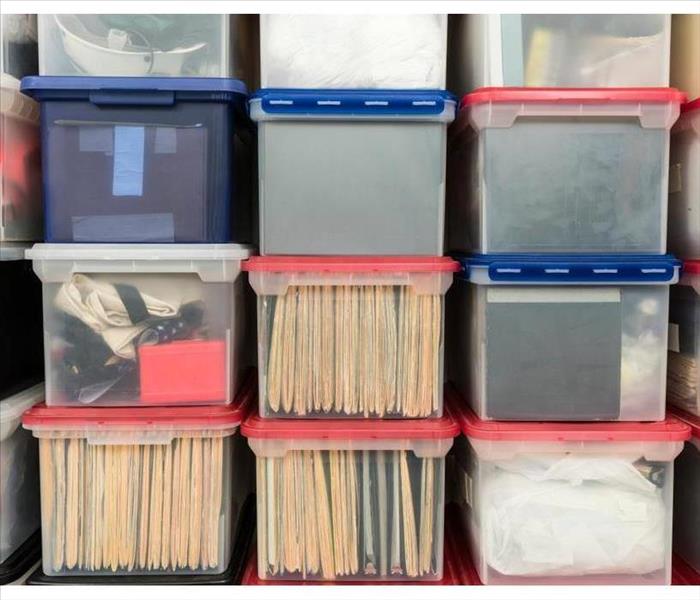 Keep important documents in a waterproof safe box.
Keep important documents in a waterproof safe box.
Knowing How To Prepare Yourself and Your Home for Flood Water
Torrential rains in Affton, MO, can be stressful for homeowners. They can also cause water damage in a flooded building or home. Knowing how to prepare yourself and your home for flood water can help reduce stress after a big storm.
Before a Storm
Homeowners can prepare for a flood by taking time to consider these precautionary steps before a storm arrives:
- Research the flood risk in Affton, MO.
- Check into insurance options available in your area.
- Create an evacuation plan, including safe routes to shelter on higher ground away from flood water.
- Invest in a sump pump with a backup battery and take measures to waterproof the basement.
- Store valuables above ground level.
Keep important documents in a waterproof safe box. You should protect homeowner’s insurance documents, health insurance policies, and identification such as passports, birth records, and marriage certificates. Consider keeping important digital files along with current photographs of the contents of your home on a flash drive in the waterproof box as well. Keep the safe box in an accessible place in your home, and remember to take it in the event of an evacuation.
Pack a disaster bag. In addition to supplies such as a change of clothes and medications, be sure to include spare car keys, a radio, flashlights, and batteries. If you have family members with special needs, consider additional equipment required for their safety.
During a Storm
Protect your family and home during a storm by heeding all emergency warnings and communications. Moving water presents unseen dangers to pedestrians and drivers, and it may be deeper than it appears. Do not try to cross flooded roads or bridges.
After a Storm
Return home only if it is safe to do so. Cleaning flood water from your home is a task best managed by professionals, such as a local residential restoration service.
It is often best to be prepared well in advance of a storm. Take precautionary steps before the rainy season, and have the number of a professional cleanup crew on hand in case your home becomes a flooded building.





 24/7 Emergency Service
24/7 Emergency Service






























